1 java8默认提供的函数式接口
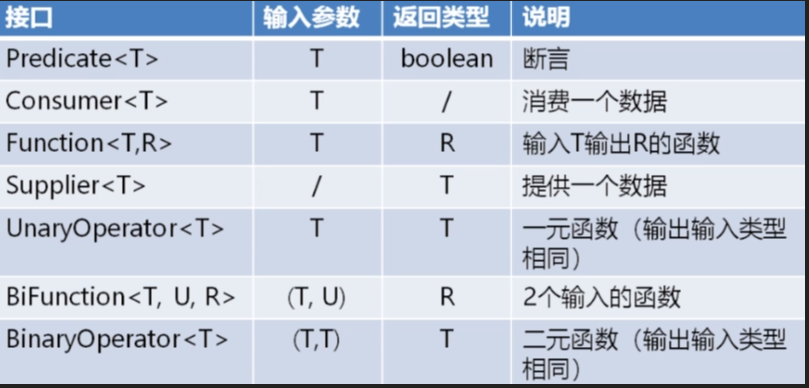
1.1 Predicate

/* * Copyright (c) 2010, 2013, Oracle and/or its affiliates. All rights reserved. * ORACLE PROPRIETARY/CONFIDENTIAL. Use is subject to license terms. * * * * * * * * * * * * * * * * * * * * */ package java.util.function; import java.util.Objects; /** * Represents a predicate (boolean-valued function) of one argument. * * <p>This is a <a href="package-summary.html">functional interface</a> * whose functional method is {@link #test(Object)}. * * @param <T> the type of the input to the predicate * * @since 1.8 */ @FunctionalInterface public interface Predicate<T> { /** * Evaluates this predicate on the given argument. * * @param t the input argument * @return {@code true} if the input argument matches the predicate, * otherwise {@code false} */ boolean test(T t); /** * Returns a composed predicate that represents a short-circuiting logical * AND of this predicate and another. When evaluating the composed * predicate, if this predicate is {@code false}, then the {@code other} * predicate is not evaluated. * * <p>Any exceptions thrown during evaluation of either predicate are relayed * to the caller; if evaluation of this predicate throws an exception, the * {@code other} predicate will not be evaluated. * * @param other a predicate that will be logically-ANDed with this * predicate * @return a composed predicate that represents the short-circuiting logical * AND of this predicate and the {@code other} predicate * @throws NullPointerException if other is null */ default Predicate<T> and(Predicate<? super T> other) { Objects.requireNonNull(other); return (t) -> test(t) && other.test(t); } /** * Returns a predicate that represents the logical negation of this * predicate. * * @return a predicate that represents the logical negation of this * predicate */ default Predicate<T> negate() { return (t) -> !test(t); } /** * Returns a composed predicate that represents a short-circuiting logical * OR of this predicate and another. When evaluating the composed * predicate, if this predicate is {@code true}, then the {@code other} * predicate is not evaluated. * * <p>Any exceptions thrown during evaluation of either predicate are relayed * to the caller; if evaluation of this predicate throws an exception, the * {@code other} predicate will not be evaluated. * * @param other a predicate that will be logically-ORed with this * predicate * @return a composed predicate that represents the short-circuiting logical * OR of this predicate and the {@code other} predicate * @throws NullPointerException if other is null */ default Predicate<T> or(Predicate<? super T> other) { Objects.requireNonNull(other); return (t) -> test(t) || other.test(t); } /** * Returns a predicate that tests if two arguments are equal according * to {@link Objects#equals(Object, Object)}. * * @param <T> the type of arguments to the predicate * @param targetRef the object reference with which to compare for equality, * which may be {@code null} * @return a predicate that tests if two arguments are equal according * to {@link Objects#equals(Object, Object)} */ static <T> Predicate<T> isEqual(Object targetRef) { return (null == targetRef) ? Objects::isNull : object -> targetRef.equals(object); } }
1.2 Consumer

/* * Copyright (c) 2010, 2013, Oracle and/or its affiliates. All rights reserved. * ORACLE PROPRIETARY/CONFIDENTIAL. Use is subject to license terms. * * * * * * * * * * * * * * * * * * * * */ package java.util.function; import java.util.Objects; /** * Represents an operation that accepts a single input argument and returns no * result. Unlike most other functional interfaces, {@code Consumer} is expected * to operate via side-effects. * * <p>This is a <a href="package-summary.html">functional interface</a> * whose functional method is {@link #accept(Object)}. * * @param <T> the type of the input to the operation * * @since 1.8 */ @FunctionalInterface public interface Consumer<T> { /** * Performs this operation on the given argument. * * @param t the input argument */ void accept(T t); /** * Returns a composed {@code Consumer} that performs, in sequence, this * operation followed by the {@code after} operation. If performing either * operation throws an exception, it is relayed to the caller of the * composed operation. If performing this operation throws an exception, * the {@code after} operation will not be performed. * * @param after the operation to perform after this operation * @return a composed {@code Consumer} that performs in sequence this * operation followed by the {@code after} operation * @throws NullPointerException if {@code after} is null */ default Consumer<T> andThen(Consumer<? super T> after) { Objects.requireNonNull(after); return (T t) -> { accept(t); after.accept(t); }; } }
1 Predicate
该接口称为断言接口,有输入也有输出;输入类型是泛型,输出类型是Boolean类型。
1.1 源代码

/* * Copyright (c) 2010, 2013, Oracle and/or its affiliates. All rights reserved. * ORACLE PROPRIETARY/CONFIDENTIAL. Use is subject to license terms. * * * * * * * * * * * * * * * * * * * * */ package java.util.function; import java.util.Objects; /** * Represents a predicate (boolean-valued function) of one argument. * * <p>This is a <a href="package-summary.html">functional interface</a> * whose functional method is {@link #test(Object)}. * * @param <T> the type of the input to the predicate * * @since 1.8 */ @FunctionalInterface public interface Predicate<T> { /** * Evaluates this predicate on the given argument. * * @param t the input argument * @return {@code true} if the input argument matches the predicate, * otherwise {@code false} */ boolean test(T t); /** * Returns a composed predicate that represents a short-circuiting logical * AND of this predicate and another. When evaluating the composed * predicate, if this predicate is {@code false}, then the {@code other} * predicate is not evaluated. * * <p>Any exceptions thrown during evaluation of either predicate are relayed * to the caller; if evaluation of this predicate throws an exception, the * {@code other} predicate will not be evaluated. * * @param other a predicate that will be logically-ANDed with this * predicate * @return a composed predicate that represents the short-circuiting logical * AND of this predicate and the {@code other} predicate * @throws NullPointerException if other is null */ default Predicate<T> and(Predicate<? super T> other) { Objects.requireNonNull(other); return (t) -> test(t) && other.test(t); } /** * Returns a predicate that represents the logical negation of this * predicate. * * @return a predicate that represents the logical negation of this * predicate */ default Predicate<T> negate() { return (t) -> !test(t); } /** * Returns a composed predicate that represents a short-circuiting logical * OR of this predicate and another. When evaluating the composed * predicate, if this predicate is {@code true}, then the {@code other} * predicate is not evaluated. * * <p>Any exceptions thrown during evaluation of either predicate are relayed * to the caller; if evaluation of this predicate throws an exception, the * {@code other} predicate will not be evaluated. * * @param other a predicate that will be logically-ORed with this * predicate * @return a composed predicate that represents the short-circuiting logical * OR of this predicate and the {@code other} predicate * @throws NullPointerException if other is null */ default Predicate<T> or(Predicate<? super T> other) { Objects.requireNonNull(other); return (t) -> test(t) || other.test(t); } /** * Returns a predicate that tests if two arguments are equal according * to {@link Objects#equals(Object, Object)}. * * @param <T> the type of arguments to the predicate * @param targetRef the object reference with which to compare for equality, * which may be {@code null} * @return a predicate that tests if two arguments are equal according * to {@link Objects#equals(Object, Object)} */ static <T> Predicate<T> isEqual(Object targetRef) { return (null == targetRef) ? Objects::isNull : object -> targetRef.equals(object); } }
1.2 test()
test方法时Predicate接口中唯一一个未实现的接口,test的存在说明Predicate是一个函数式接口;该方法接收任意类型的数据,返回值是一个布尔类型,如果输入参数满足test方法体中的逻辑就返回true,否则返回false

/** * Evaluates this predicate on the given argument. * * @param t the input argument * @return {@code true} if the input argument matches the predicate, * otherwise {@code false} */ boolean test(T t);
技巧01:利用lambda表达式来实现Predicate接口中的test方法【PS: 也可以利用匿名内部类或者实现类来实现】
1.2.1 需求
判断一个Integer类型的数据是否大于10
1.2.2 思路
》创建一个类型为Predicate的实例【利用lambda表达式实现】
》调用Predicate实例的test方法进行判断,test方法的参数就是待判断的数据
1.2.3 代码实现


package demo05_webflux.chapter02; import java.util.function.Predicate; /** * @author 王杨帅 * @create 2018-07-29 14:29 * @desc 函数式接口 **/ public class Case05_FunctionDemo { public static void main(String[] args) { whetherThan10(11); } public static void whetherThan10(Integer num) { Predicate<Integer> predicate = i -> i > 10; System.out.println(num + "和10比较的结果为:" + predicate.test(num)); } }
1.3 and()
and方法是Predicate中的一个默认方法,该方法接收一个Predicate类型的实例返回一个Predicate类型的实例;
相当于将两个Predicate类型的实例结合起来,只有待判断的数据满足这两个Predicate类型实例的test方法时才返回true,否则返回false

/** * Returns a composed predicate that represents a short-circuiting logical * AND of this predicate and another. When evaluating the composed * predicate, if this predicate is {@code false}, then the {@code other} * predicate is not evaluated. * * <p>Any exceptions thrown during evaluation of either predicate are relayed * to the caller; if evaluation of this predicate throws an exception, the * {@code other} predicate will not be evaluated. * * @param other a predicate that will be logically-ANDed with this * predicate * @return a composed predicate that represents the short-circuiting logical * AND of this predicate and the {@code other} predicate * @throws NullPointerException if other is null */ default Predicate<T> and(Predicate<? super T> other) { Objects.requireNonNull(other); return (t) -> test(t) && other.test(t); }
1.3.1 需求
判断一个Integer类型的数据介于5到10之间
1.3.2 思路
》实例化两个Prdicate类型的实例【利用lambda表达式实现】
》》predicate01这个实例负责判断数据大于5
Predicate<Integer> predicate01 = i -> i > 5;
》》predicate02这个数据负责判断数据小于10
Predicate<Integer> predicate02 = i -> i < 10;
》利用Predicatae类型的and方法将两个Predicate类型的实例进行整合
Predicate<Integer> predicate03 = predicate01.and(predicate02);
》利用组合后的Prdicate类型的实例调用test方法去判断数据是否满足条件
System.out.println(predicate03.test(6));
1.3.3 代码实现
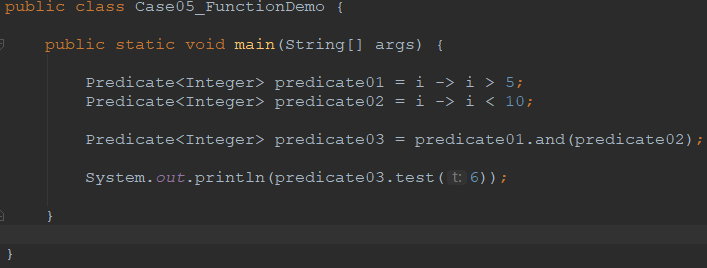

package demo05_webflux.chapter02; import java.util.function.Predicate; /** * @author 王杨帅 * @create 2018-07-29 14:29 * @desc 函数式接口 **/ public class Case05_FunctionDemo { public static void main(String[] args) { Predicate<Integer> predicate01 = i -> i > 5; Predicate<Integer> predicate02 = i -> i < 10; Predicate<Integer> predicate03 = predicate01.and(predicate02); System.out.println(predicate03.test(6)); } }
1.4 or()
or方法是Predicate中的一个默认方法,该方法接收一个Predicate类型的实例返回一个Predicate类型的实例;
相当于将两个Predicate类型的实例结合起来,只有待判断的数据满足这两个Predicate类型实例的test方法中的任何一个时都可以返回true,都不满足时才返回false
1.4.1 需求
判断一个Integer类型的数据是否小于等于5,或者大于等于10
1.4.2 思路
》实例化两个Prdicate类型的实例【利用lambda表达式实现】
》》predicate01这个实例负责判断数据小于等于5
Predicate<Integer> predicate01 = i -> i <= 5;
》》predicate02这个数据负责判断数据大于等于10
Predicate<Integer> predicate02 = i -> i >= 10;
》利用Predicatae类型的and方法将两个Predicate类型的实例进行整合
Predicate<Integer> predicate03 = predicate01.or(predicate02);
》利用组合后的Prdicate类型的实例调用test方法去判断数据是否满足条件
System.out.println(predicate03.test(3));
1.4.3 代码实现
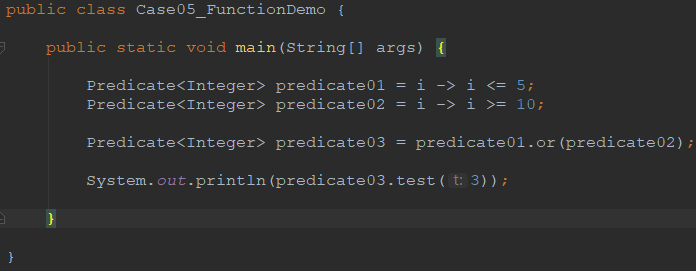

package demo05_webflux.chapter02; import java.util.function.Predicate; /** * @author 王杨帅 * @create 2018-07-29 14:29 * @desc 函数式接口 **/ public class Case05_FunctionDemo { public static void main(String[] args) { Predicate<Integer> predicate01 = i -> i <= 5; Predicate<Integer> predicate02 = i -> i >= 10; Predicate<Integer> predicate03 = predicate01.or(predicate02); System.out.println(predicate03.test(3)); } }
1.5 negate()
negate方法也是Predicate方法中的一个默认方法,该方法不接受参数,返回一个Predicate类型的实例;
negate方法的主要作用是对原Predicate方法的test逻辑进行取反操作

/** * Returns a predicate that represents the logical negation of this * predicate. * * @return a predicate that represents the logical negation of this * predicate */ default Predicate<T> negate() { return (t) -> !test(t); }
1.5.1 需求
判断一个Integer类型的数据是否小于等于5,不能用 < 和 = 这两个操作符
1.5.2 实录
》创建一个predicate类型的实例predicate01用来判断Integer类型的数据大于5
Predicate<Integer> predicate01 = i -> i > 5;
》利用predicate01实例创建一个Predicate类型的实例predicate02用来判断Integer类型的数据小于等于5
Predicate<Integer> predicate02 = predicate01.negate();
》调用predicate02的test方法来判断一个Intehger类型的实例是否小于等于5,如果满足条件就返回true,否则返回false
System.out.println(predicate02.test(6));
1.5.3 代码实现
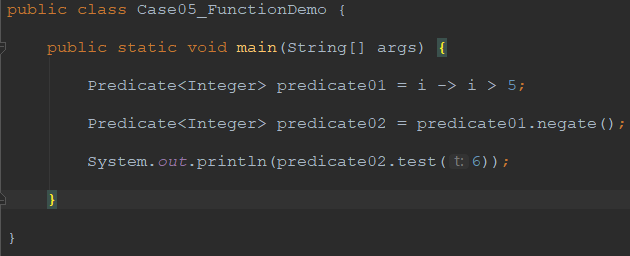

package demo05_webflux.chapter02; import java.util.function.Predicate; /** * @author 王杨帅 * @create 2018-07-29 14:29 * @desc 函数式接口 **/ public class Case05_FunctionDemo { public static void main(String[] args) { Predicate<Integer> predicate01 = i -> i > 5; Predicate<Integer> predicate02 = predicate01.negate(); System.out.println(predicate02.test(6)); } }
1.6 isEqual
isEqual方法是Predicate接口的一个静态方法,该方法接收一个引用类型的变量,返回一个Predicate类型的实例;
调用isEaual方法返回的Predicate类型实例的test方法时,会将test方法的参数和isEqual方法参数进行equals比较

/** * Returns a predicate that tests if two arguments are equal according * to {@link Objects#equals(Object, Object)}. * * @param <T> the type of arguments to the predicate * @param targetRef the object reference with which to compare for equality, * which may be {@code null} * @return a predicate that tests if two arguments are equal according * to {@link Objects#equals(Object, Object)} */ static <T> Predicate<T> isEqual(Object targetRef) { return (null == targetRef) ? Objects::isNull : object -> targetRef.equals(object); }
1.6.1 需求
判断一个String类型的数据是否等于“xyj_fury”
1.6.2 思路
》利用Predicate接口的默认方法isEqual来创建一个Predicate类型的实例predicate
Predicate<String> predicate = Predicate.isEqual("xyj_fury");
》调用predicate实例的test方法来判断一个String类型的数据是否和 “xyj_fury”相等
System.out.println(predicate.test("xyj_fury"));
1.6.3 代码实现


package demo05_webflux.chapter02; import java.util.function.Predicate; /** * @author 王杨帅 * @create 2018-07-29 14:29 * @desc 函数式接口 **/ public class Case05_FunctionDemo { public static void main(String[] args) { Predicate<String> predicate = Predicate.isEqual("xyj_fury"); System.out.println(predicate.test("xyj_fury")); } }
2 Consumer
该接口是一个消费者接口,只有输入没有输出;输入是一个泛型类型。

/* * Copyright (c) 2010, 2013, Oracle and/or its affiliates. All rights reserved. * ORACLE PROPRIETARY/CONFIDENTIAL. Use is subject to license terms. * * * * * * * * * * * * * * * * * * * * */ package java.util.function; import java.util.Objects; /** * Represents an operation that accepts a single input argument and returns no * result. Unlike most other functional interfaces, {@code Consumer} is expected * to operate via side-effects. * * <p>This is a <a href="package-summary.html">functional interface</a> * whose functional method is {@link #accept(Object)}. * * @param <T> the type of the input to the operation * * @since 1.8 */ @FunctionalInterface public interface Consumer<T> { /** * Performs this operation on the given argument. * * @param t the input argument */ void accept(T t); /** * Returns a composed {@code Consumer} that performs, in sequence, this * operation followed by the {@code after} operation. If performing either * operation throws an exception, it is relayed to the caller of the * composed operation. If performing this operation throws an exception, * the {@code after} operation will not be performed. * * @param after the operation to perform after this operation * @return a composed {@code Consumer} that performs in sequence this * operation followed by the {@code after} operation * @throws NullPointerException if {@code after} is null */ default Consumer<T> andThen(Consumer<? super T> after) { Objects.requireNonNull(after); return (T t) -> { accept(t); after.accept(t); }; } }
2.1 accept
accept是Consumer中那个为实现的方法,Consumer类型的实例只要调用accept方法就相当于消费了数据;该方法接受一个泛型类型,没有返回值。

/** * Performs this operation on the given argument. * * @param t the input argument */ void accept(T t);
2.1.1 需求
打印获取到的String类型数据到控制台,用标准输出函数打印和日志打印两种方式实现
2.1.2 思路
》创建一个Consummer类型的实例 consumer
Consumer<String> consumer = i -> {
System.out.println(i);
log.info(i);
};
》调用consumer实例的accept方法
consumer.accept("你好");
2.1.3 代码实现
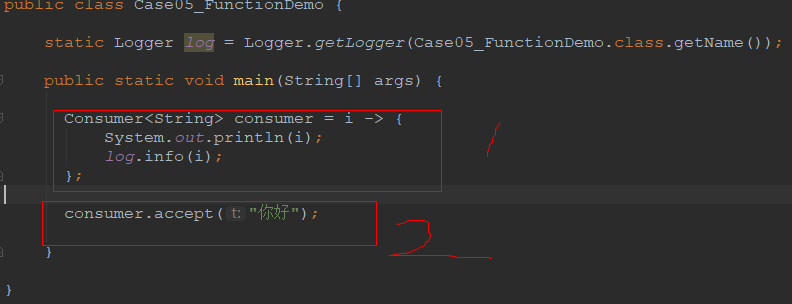

package demo05_webflux.chapter02; import java.util.function.Consumer; import java.util.logging.Logger; /** * @author 王杨帅 * @create 2018-07-29 14:29 * @desc 函数式接口 **/ public class Case05_FunctionDemo { static Logger log = Logger.getLogger(Case05_FunctionDemo.class.getName()); public static void main(String[] args) { Consumer<String> consumer = i -> { System.out.println(i); log.info(i); }; consumer.accept("你好"); } }
2.2 andThen
该方法时Consumer接口中的一个默认方法;该方法接收一个Consummer类型的实例,也返回一个Consummer的实例;该方法的作用是对同一个数据再次进行消费。

/** * Returns a composed {@code Consumer} that performs, in sequence, this * operation followed by the {@code after} operation. If performing either * operation throws an exception, it is relayed to the caller of the * composed operation. If performing this operation throws an exception, * the {@code after} operation will not be performed. * * @param after the operation to perform after this operation * @return a composed {@code Consumer} that performs in sequence this * operation followed by the {@code after} operation * @throws NullPointerException if {@code after} is null */ default Consumer<T> andThen(Consumer<? super T> after) { Objects.requireNonNull(after); return (T t) -> { accept(t); after.accept(t); }; }
2.2.1 需求
将接收到的String类型的数据拼接“fury”后以标准输出的方式打印到控制台,并且将接收到的数据拼接“warrior”后用日志的形式打印到控制台。
2.2.2 思路
》创建一个类型为Consumer的实例consumer01用来接收数据,并将接收到的数据拼接上“fury”后再打印
Consumer<String> consumer01 = i -> System.out.println(i + "fury");
》创建一个类型为Consumer的实例consumer02用来接收数据,并将接收到的数据拼接上“warrior”后再打印
Consumer<String> consumer02 = i -> System.out.println(i + "warrior");
》调用consumer01的andThen方法来接收consumer02并返回第三个Consumer类型的数据consumer03
Consumer<String> consumer03 = consumer01.andThen(consumer02);
》调用consumer03实例的accept方法来消费数据
consumer03.accept("你好");
2.2.3 代码实现
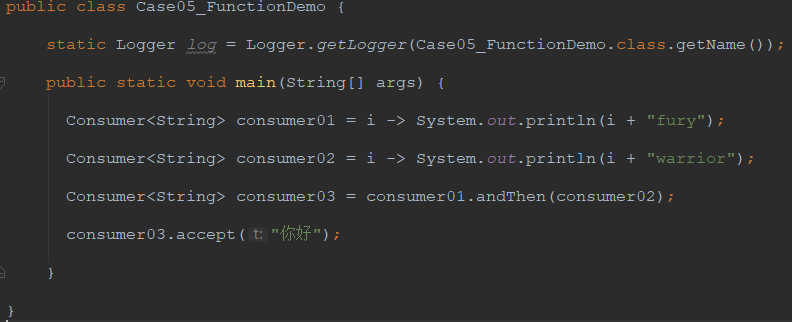

package demo05_webflux.chapter02; import java.util.function.Consumer; import java.util.logging.Logger; /** * @author 王杨帅 * @create 2018-07-29 14:29 * @desc 函数式接口 **/ public class Case05_FunctionDemo { static Logger log = Logger.getLogger(Case05_FunctionDemo.class.getName()); public static void main(String[] args) { Consumer<String> consumer01 = i -> System.out.println(i + "fury"); Consumer<String> consumer02 = i -> System.out.println(i + "warrior"); Consumer<String> consumer03 = consumer01.andThen(consumer02); consumer03.accept("你好"); } }
